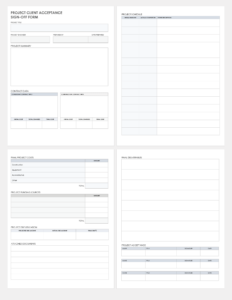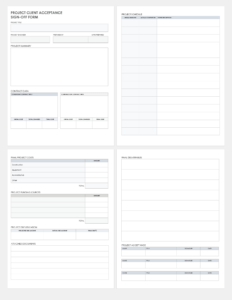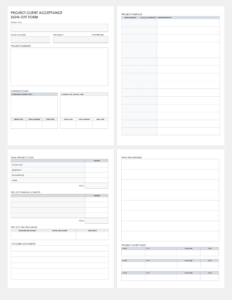User Acceptance Testing, often shortened to UAT, is a crucial phase in any software development or system implementation project. It is the final stage where end-users rigorously test the system to ensure it meets their business requirements and is fit for purpose before going live. Without proper UAT, you risk deploying a system that doesn’t quite hit the mark, leading to user frustration, costly rework, and potential delays.
While the testing itself is vital, documenting the results and obtaining formal approval is equally important. This is where a robust UAT sign-off document template becomes an indispensable tool. It provides a clear, official record that all agreed-upon functionalities have been tested, bugs addressed, and stakeholders are satisfied, giving everyone the confidence to move forward.
Why a UAT Sign-Off Document is Absolutely Crucial
Imagine launching a new system without a clear, documented agreement that the users are happy with it. It sounds like a recipe for disaster, doesn’t it? A UAT sign-off document isn’t just a piece of paper; it’s a formal declaration that the software or system has met the specified business requirements from the end-user perspective. It marks the successful completion of the UAT phase, moving the project closer to deployment.
This document serves as a protective shield for both the development team and the client or business stakeholders. For the development team, it provides proof that the delivered solution aligns with user expectations as of the sign-off date, mitigating scope creep or last-minute feature requests after launch. For the business, it ensures that they have thoroughly reviewed and accepted the system, taking ownership of its readiness for operational use.
Moreover, a well-executed sign-off process fosters accountability. It encourages stakeholders to take their UAT responsibilities seriously, knowing that their formal approval is required. This often leads to more thorough testing and clearer communication of issues, ultimately resulting in a higher quality product upon release. It also creates a historical record that can be invaluable for future audits, troubleshooting, or understanding the project’s journey.
Key Components You Can’t Miss
To ensure your UAT sign-off document is comprehensive and effective, it should include several critical sections. Think of these as the building blocks that make your document truly impactful and legally sound.
- Project Details: Clearly state the project name, version being tested, and the dates of the UAT period. This grounds the document in a specific context.
- Test Scope and Objectives: Briefly reiterate what was covered in the UAT and the goals of the testing phase. This ensures everyone is on the same page regarding the extent of the testing.
- Testing Results Summary: Provide an overview of the testing outcomes, including the number of test cases executed, passed, failed, and any outstanding defects or known issues with agreed-upon resolutions.
- Deviation Log or Outstanding Items: List any issues that were identified but are accepted as minor or will be addressed in a future release, along with a plan for their resolution.
- Sign-Off Section: This is the heart of the document. It should include spaces for the names, titles, and signatures of all key stakeholders (e.g., UAT Lead, Business Owner, Project Manager) indicating their acceptance.
- Date of Sign-Off: Crucial for historical record and accountability.
Having these components ensures that your UAT sign-off document template is not just a formality but a valuable piece of project documentation.
Crafting Your Perfect UAT Sign-Off Document Template
While you can certainly find numerous examples online, tailoring your uat sign off document template to your organization’s specific needs and project methodologies is paramount. A generic template might cover the basics, but a customized one will integrate seamlessly with your existing processes, making it easier for your teams to adopt and use consistently across various projects.
Start by considering the level of detail required for your projects. Are your projects highly regulated, requiring extensive detail on every test case and defect, or are they more agile, needing a leaner, more concise summary? The template should reflect this. You might also want to include sections for screenshots of critical tests or links to test management tools where detailed test results reside. The goal is to make it as useful and easy to complete as possible, without becoming an overly burdensome administrative task.
Engage your key stakeholders early in the template design process. Get input from project managers, quality assurance leads, business analysts, and even end-users who will be signing off. Their perspectives will help ensure the template captures all necessary information and is practical for everyone involved. A template that’s co-created is far more likely to be embraced and utilized effectively across your organization.
- Keep it Clear and Concise: Avoid jargon where possible and make sure the language is straightforward. The document should be easily understood by all stakeholders, technical or non-technical.
- Include Version Control: Always have a section for document versioning. This is critical for tracking changes to the template itself and for specific project sign-off documents, ensuring you’re always looking at the latest approved version.
- Define Roles and Responsibilities: Clearly state who is responsible for what in the sign-off process. This avoids confusion and ensures timely completion.
- Consider Digital Signatures: For efficiency, explore options for digital signatures to streamline the approval process, especially for distributed teams.
By investing time in creating a well-structured and tailored template, you’re not just creating a document; you’re building a foundation for smoother project closures and more successful system deployments. It’s an investment that pays dividends in clarity, accountability, and reduced risk.
Establishing a robust UAT sign-off process, supported by a meticulously designed document, significantly enhances project governance. It provides a definitive point of closure for the user acceptance testing phase, allowing teams to confidently transition to deployment knowing that the users have officially approved the solution. This formal acceptance minimizes post-launch surprises and creates a clear audit trail for compliance and future reference.
Ultimately, a well-defined sign-off procedure contributes to overall project success by fostering collaboration, ensuring quality, and building trust among all stakeholders. It’s about more than just checking a box; it’s about confirming readiness and setting the stage for a smooth and effective rollout of your new system or software.


